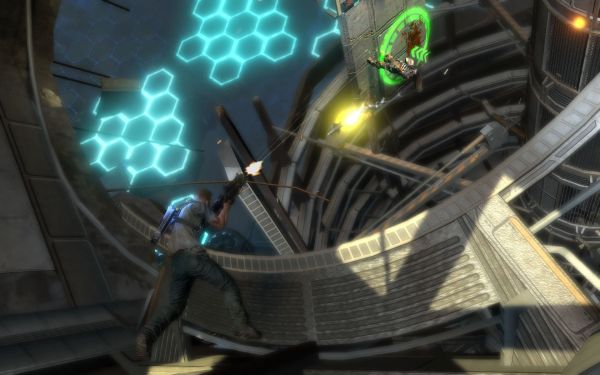

Inversion possesses two different types of gameplay: the campaign and the multiplayer. Let’s start with the multiplayer. Within the multiplayer there are several types of modes which support anywhere from a max of 4 to 12 players, depending on the mode. All but one of these modes are competitive, being divided into deathmatch and team deathmatch type of gameplay. The last mode is a co-operative survival mode, which features a standard Horde-like set-up. Up to 4 players can join up to fend off waves of enemies which get progressively tougher. The gravity mechanics from the campaign can be utilized here for an extra bit of flavor and three different maps are offered for this mode.
Players can either set up their own lobby for the various multiplayer modes, or use the matchmaking system. If you plan on buying or renting Inversion, however, I would suggest not relying too much on the matchmaking system. The community for the game (or at least the amount of people utilizing the matchmaking system) appears extremely small, even just a week after the game’s release. Several times I attempted to use the matchmaking system to find either a survival or competitive game, and was unsuccessful. One time I even sat waiting for 15 minutes for the survival mode and found only one other person who dropped back out after waiting for a couple minutes when it was clear we weren’t going to find others anytime soon. Bizarrely enough, there is no matchmaking for the campaign, so if you want to even play the campaign in co-op, you’ll need to convince a friend to also pick up the game.

This brings us to the bulk of the gameplay of Inversion: the campaign. The story campaign is the same for single-player or 2-player co-op. To my extreme disappointment, Inversion now only supports online co-op, though in the past I was repeatedly informed that it would also have local splitscreen co-op as well. Other publications were told the same thing, and I’ve run across many forum posts online from players who bought the game expecting local co-op to only fire up the game and realize this was not an option. If you are one such player, we’re certainly sorry we misinformed you, but understand that we were misled as well. As such, it was difficult for me to get rid of the bad taste in my mouth of, what I felt to be, deceit.
I pressed on, however, and did my best to give the campaign a fair shake. In online co-op, players take control over tough guys Davis and Leo. Davis is clearly the main character, though, and if you play the campaign in single-player, the AI will control Leo. To be completely blunt, the story of the campaign is extremely simple and not very original. Mysterious invaders (called the Lutadores) have arrived, the populace is murdered and enslaved, and Davis is desperately seeking his daughter who has been lost in all the chaos. Hmm, this seems a little familiar... The dialogue is often poorly written and unimaginative, and, perhaps as a response to this, the voice actors’ performances ring hollow and lifeless.

Okay, but stick with me here, because all is not lost. The gameplay isn’t half bad, featuring a standard third-person shooter with cover system. The special Grav-Link gun mechanic allows Inversion to reasonably differentiate itself from the third-person shooter crowd, offering both High Gravity and Low Gravity settings. These different gravity types allow players to do a variety of things such as pop up enemies into the air, throw objects (even as large as cars) at enemies, or pin enemies to the ground. Though there is a special gravity ammo type, I almost never found myself scarce on either gun ammo or gravity ammo, which was probably a smart move on the developer’s part. If I had to scour for ammo on top of everything else, I very likely would not have made it through the game.
Perhaps the best thing about Inversion is the sense of progression throughout the game as well as the curve of difficulty. While there is no specific character progression, new types of guns become available as drops on the ground, and new gravity powers become unlocked. I certainly felt stronger at the end of the game as opposed to the start, which I often don’t feel like is the case in this type of genre. Inversion also provides a healthy smattering of bosses and minibosses which provide a continuously more difficult challenge. There’s no difficulty peak where I would say everything was easy up until a certain boss. There’s a nice curve throughout the game, which I certainly appreciate.
All in all, Inversion provides a decent combat experience, but suffers from a bland story and stock characters. If you have a buddy you can play with online and both of you can overlook the plot in favor of the combat, you could probably have a good time with the game. In any other situation, however, Inversion falls flat on its face. With the removal of local co-op, no matchmaking for the co-op campaign, and little hope of utilizing the matchmaking system for the modes it does support, it becomes a very tough sell. To be honest, it pains me to say it because I originally had pretty high hopes for the game. The gravity mechanics can be fun and interesting, and if you’re a die-hard third-person shooter fan who can favor combat in the face of anything else, Inversion may be a good pick-up for you. For anyone else, however... well, it might be best if Inversion floats on off to a rainy day rental.
Editor's Note: The Co-Optimus Co-Op Review of Inversion was based off of the Xbox 360 version of the game.